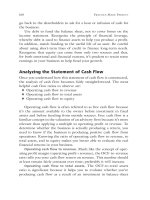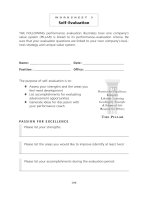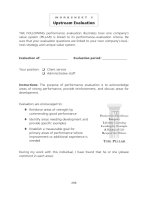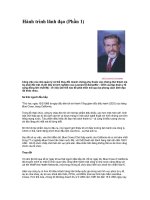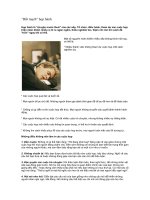Tài liệu Practice Made Perfect 17 ppt
Bạn đang xem bản rút gọn của tài liệu. Xem và tải ngay bản đầy đủ của tài liệu tại đây (122.09 KB, 10 trang )
138 PRACTICE MADE PERFECT
the availability of inexpensive accounting-software tools and capable
bookkeepers. Although the process does add temporarily to your
administrative costs, the insight you obtain will help you become a
more effective decision maker. Furthermore, accounting and finan-
cial management are fundamental to running any business. You’re
making an investment of time, money, management, and energy. Do
you recommend investments for your clients without understanding
how that money will be deployed or how the return should be real-
ized? Without a clear understanding of the unique financial dynam-
ics of your practice, there is no way to know if you’re doing things
right.
One advisory firm we worked with had grown its top line 15–20
percent a year for four years in a row. When we met the owner, his
practice was generating $3 million in annual revenues; his take-
home pay was $75,000. He was thrilled by the top line but couldn’t
figure out why he was making so little. If you were he, wouldn’t you
want to know how to evaluate your results before continuing such a
growth plan?
This chapter reviews the fundamentals of accounting so that we
can demonstrate effective financial-management techniques. We
defer to the bookkeepers and accountants (and accounting text-
books) on the actual entries into a general ledger and how they’re
translated into a financial statement. But we provide some essentials
regarding what should be tracked on your financial statements and
which details should be kept separate so that you can dig deeper
into the questions that may arise. You’ll also find in the appendix a
sample chart of accounts and other forms in worksheets 7 through
10. The goal is to offer a management guide, not a bean counter’s
how-to. Having a solid understanding of the financial dynamics of
your business can be one of the most useful management tools for
understanding which strategic and operations decisions the data
point to.
Constructing a Financial Statement
Every month, every financial-advisory firm should produce three
financial statements:
THE TOOLS THAT COUNT: FINANCIAL MANAGEMENT 139
1. A balance sheet
2. An income statement (also known as the P&L, or profit and
loss statement)
3. A statement of cash flow
These statements are interrelated, but each is important in its own
right. Although each of the statements is about something different,
together they provide the complete story on the underlying econom-
ics of a practice. Unfortunately, most owners of advisory firms regard
the balance sheet as a cover page and the income statement as a
scorecard. They look to either the bottom line or the top line to see
how it tallies and then file the statement away. When you understand
how rich this information is, you will likely begin to view the data
quite differently. We know that the accounting side of a business can
be mind numbing for business owners—even financial advisers who
deal with numbers every day. But once mastered, the language will
come naturally to you.
The Balance Sheet
One reason the balance sheet is unappreciated by most advisers—or
by most service-business owners, for that matter—is it gives the false
perception that a firm has very few assets (in terms of current and
fixed assets, as opposed to assets under management). In many cases,
not all of the firm’s assets are recorded. In other cases, the method of
accounting forces the balance sheet to be bypassed altogether.
Typical items left off the balance sheet include work in process
(WIP), prepaid fees (retainers) and prepaid expenses, certain fixed
assets, and shareholder loans. They may be omitted because the
firm lacks an effective means of tracking the data or because it uses
cash-basis accounting instead of the accrual method to prepare the
financial statements.
One adage people like to cite in describing a balance sheet is that
it tells you what you own and what you owe. This is somewhat of a
misconception. The balance sheet tells you what you own and how
you fund it. Assets are funded with a combination of liabilities and
equity. The more a financial-advisory firm grows, the more its bal-
ance-sheet assets grow. Since all balance sheets are supposed to bal-
140 PRACTICE MADE PERFECT
ance, it also becomes necessary for the funding side to grow. How
will you fund your balance sheet—with equity or with debt? If debt,
what kind? If equity, where will that equity come from? Let’s look at
some possible answers.
Worksheet 7 in the appendix provides an industry standard balance-
sheet chart of accounts for your use, summarized in Figure 8.1. On the
left side of the balance sheet are the assets. They’re separated into two
categories: current assets and fixed assets.
Current assets. Current assets convert to cash in one year or less
and include cash, accounts receivable, and WIP. Work in process is
unbilled revenue and is recognized as an asset when you perform bill-
able work for a client but have not yet invoiced for it—in other words,
the asset will eventually turn into cash when billed and collected (see
“Work in Process,” at right). Prepaid expenses also appear as a current
asset and are reduced as an asset as they are applied, such as an annual
prepaid insurance premium that’s recognized in part each month.
Fixed assets. Fixed assets do not convert to cash and generally
include furniture and fixtures, leasehold improvements, equipment,
and other assets that are necessary for the operation of the business.
Source: © Moss Adams LLP
FIGURE 8.1 Balance Sheet
Current
assets
Fixed
assets
Current
liabilities
Long-term
debt
Equity
Net
working
capital
THE TOOLS THAT COUNT: FINANCIAL MANAGEMENT 141
Occasionally, you’ll also find personal assets like automobiles, air-
planes, and condos on a business’s financial statements. Such assets
may be found on the balance sheet even when the assets are leased,
which, obviously is incorrect accounting (the lessor, not the business,
owns the asset). Intangible assets such as copyrights, trademarks,
and goodwill may be carried on the balance sheet, though there
are certain accounting rules for recognizing these assets, which an
accountant can explain.
Assets are placed on a balance sheet in order of liquidity, with
the most liquid assets at the top and the least liquid at the bottom.
On the right side of the balance sheet are the funding sources. In a
business, you fund your assets with a combination of liabilities (debt)
and equity. The right side generally has three components: current
liabilities, long-term debt, and equity.
Work in Process
WORK IN PROCESS (WIP) is a part of all service businesses. WIP occurs in
a financial-advisory firm when you do planning for a fee or in expectation
of producing other fees from the client once the planning and consulting
work is done. But most financial-advisory firms have no way to account
for the work because they do not track time related to client engagements.
In accounting language, WIP represents unbilled revenue and is carried on
the balance sheet as a current asset. Once WIP is billed, it becomes part of
accounts receivable. Typically WIP is recorded when a firm tracks its time and
can assign the value of its time to this asset. WIP can also be recognized on
a percentage-of-completion basis.
It’s important to track WIP because the work consumes a lot of cash. In a
financial-advisory firm’s working-capital cycle, the firm gets the client first, then
it produces the work, bills for the service, and collects the fee. Current assets,
not including cash itself, comprises prepaid fees, accounts receivable, and WIP.
As a business grows and has new clients and new activity, accounts receivable
and WIP should also grow. Since a balance sheet needs to balance, you must
find a way to fund this growth in assets. Should you use debt or equity?
142 PRACTICE MADE PERFECT
Current liabilities. Current liabilities are short-term obligations;
they’re bills that are due in one year or less. They include accounts pay-
able, the current payments due on long-term debt, and notes payable
(amounts due on a line of credit, for example). Retainers or prepaid
fees would also be treated as a current liability because you have an
obligation to earn those fees over the period they’re being accrued;
prepaid asset-management fees would typically be amortized over a
quarter. A retainer fee might be amortized over the full year.
Long-term debt. This debt is an obligation due in more than one
year, typically including mortgages, term loans for equipment financ-
ing, and obligations for purchases of other practices. Sometimes
shareholder loans are categorized as long-term debt, but in reality
such loans should be counted as equity because they rarely are paid
back to the shareholder.
Equity. Equity is the shareholders’ investment in the business and
is also a critical part of funding the assets. Equity can come from
only two sources: new capital or retained earnings (profits kept in
the practice rather than distributed to the owners). Most practices
begin with a nominal amount of new capital invested by the founder.
New shareholders may also contribute to capital. When earnings (or
profits) are retained in the business, equity grows. When the busi-
ness shows net losses instead of profits, equity shrinks.
Many people presume that equity is determined by the difference
between assets and liabilities. Although this is mathematically cor-
rect, the calculation tends to distort judgment about how a healthy
balance sheet is built. In other words, using this definition, people
often erroneously assume that if they increase their assets, they will
have more equity. In reality, when the asset side of the balance sheet
grows, the funding side must grow as well. So if the business does
not show a profit and the owner does not contribute more capital,
the only way the funding side can grow is by increasing the debt.
What’s most important to understand is that revenues drive asset
growth. The more a business grows, the more its balance-sheet assets
will grow. A firm will require more furniture and fixtures, more
equipment, more office space—and if it accounts for these things, its
accounts receivable and WIP will also grow. If the business fails to
achieve profitability, or if earnings are not retained in the business,
THE TOOLS THAT COUNT: FINANCIAL MANAGEMENT 143
the only way to fund the increases in assets is by borrowing more
money from the bank, from a creditor, or from the owner(s). This is
often the point at which owners take money out of their own pockets
to put back into the practice, but emotionally and financially, this
can cause a strain on the owner(s).
The Income Statement
Most advisers are familiar with an income, or P&L, statement because
it’s the tool they use to keep score. However, we’ve found that it’s
undervalued as a management tool because practitioners do not know
how to interpret key components of this important document.
The most common format for an adviser’s income statement is:
Revenue
– Expenses
= Owner’s income
This approach may work if all you want to know is the score, but
it is completely inadequate if you’re trying to manage a business.
Such shortcuts are as inefficient for a sole practitioner as they are for
a larger firm. To begin with, the income statement should be broken
into five critical elements:
Revenue
– Direct expense
= Gross profit
– Overhead expenses
= Operating profit
Worksheet 8 in the appendix provides an industry standard
income-statement chart of accounts for your use, displayed graphi-
cally in Figure 8.2 on the following page.
Revenue. The dollar amount that flows into your practice from all
business activities—including all fees and commissions—is revenue. For
example, firms affiliated with a broker-dealer would record revenues
net of the broker-dealer’s house fees. Firms that use a custodian and
assess a planning or asset-management fee would record total receipts.
144 PRACTICE MADE PERFECT
Direct expenses. A direct expense is defined as the reward for
professional labor and should include base compensation for profes-
sional staff, whether fixed (salary) or variable (commission or incen-
tive) compensation. Direct expenses should also include any referral
fees or commissions paid to internal or external sources of business
development (CPA referral fees, et cetera). The professional staff sala-
ries should include fair-market compensation to the owner for the
work the owner does as an adviser. If you’re a sole practitioner, this
would be an appropriate way to categorize fair-market compensa-
tion for yourself. To better understand what this “reward for labor”
should be, see chapter 7 on compensation. While individual incentive
payments are included in direct expense, profit sharing, which comes
out of the bottom line, is accounted for in the other expense category
on the income statement.
Gross profit. The amount left over after direct expenses are paid
is the gross profit. Pay attention to this amount because it is what
you use to cover your overhead expenses and produce an operating
profit. If the gross profit is insufficient to do either, your business
will be in big trouble.
FIGURE 8.2 Income Statement
Revenue
Direct
Expense
Gross
Profit
Overhead
Expenses
Operating
Profit
Net
Income
Other
Income/
Expense
Source: © Moss Adams LLP
THE TOOLS THAT COUNT: FINANCIAL MANAGEMENT 145
Overhead expenses. Overhead expenses are all general and
administrative expenses such as rent, utilities, marketing, manage-
ment, administrative, and support staff, benefits, etc.
Operating profit. Operating profit is what’s left over after all
expenses are paid. This is also known as return on revenue, or return
on sales. Different people refer to this number in different ways;
operating profit is sometimes referred to as operating income or
earnings. For your purposes, you should think of operating profit as
your reward for ownership. Later we’ll explain two other important
concepts: return on investment (ROI) and return on assets (ROA).
It may also be appropriate to add lines for other income/expenses
to the extent that this item is relevant in your practice; you might add
a line for taxes if your business is a taxable entity such as a C corpo-
ration in the United States. An example of other income might be
rental income or a special distribution; an example of other expenses
might be an amount paid to settle a claim. Operating profit should
record the net from operations and should not be cluttered with
nonoperating income and expenses.
The primary reason for categorizing your income statement this
way is to help you become a more effective financial manager for
your business. By using a consistent chart of accounts, consistent
language, and a consistent interpretation of the data, you’ll be able
to compare your firm meaningfully to other practices and to its own
historical performance and identify where you may be having prob-
lems. But one problem with many advisory-firm income statements
is that advisers overload each category with details instead of pre-
senting the statements in key summary form. For example, the over-
head expense numbers often include every single disbursement, no
matter how small, and every person’s monthly salary. Many of these
lines should be presented in summary so that the financials tell the
broader story first. Details are important but should be contained in
backup documents in the event you need to drill deeper.
Accrual versus Cash-Basis Accounting
Cash-basis accounting. Most advisory firms prefer to use cash-basis
accounting because it’s simpler in some respects, although it does not
always accurately reflect the economics of the practice. In cash-basis
146 PRACTICE MADE PERFECT
accounting, you recognize revenues when received and expenses
when paid. The method is much like balancing a personal check-
book—you either have the money or you don’t. For most practices,
cash-basis accounting is appropriate for tax purposes but not for
managing finances.
Accrual accounting. Accrual accounting allows a firm to measure
profitability more accurately because it matches up the revenues and
expenses to appropriate time periods. With accrual accounting, you
recognize the revenues when earned even though the services may
not have been paid for yet. More likely, clients have prepaid if the
firm assesses quarterly payments based on assets under management.
You recognize expenses when incurred, even though you may not
yet have paid for them. On the revenue side, if staff members are
working on a financial plan, for example, they record their time
and you recognize the revenue in that time period. This revenue is
matched to their monthly salaries, so that you can evaluate whether
you’re producing a profit on their labor. If you’re not, you can take
corrective action when the problem becomes chronic or a trend is
indicated.
Tax management versus financial management. Please do not
confuse your financial statements with your tax returns. They have
different purposes and different formats. Tax returns provide very
little insight into what’s going on in your business from a financial-
management perspective. People joke about having two sets of books,
but in reality, that practice is legitimate—one set is for taxes, the
other is for financial management. Most advisory firms use cash-basis
accounting if they’re eligible to do so, because it’s usually benefi-
cial from a tax standpoint; however, it’s prudent to consider accrual
accounting for your management reports, because that method gives
you more insight into your business operations.
The Statement of Cash Flow
The statement of cash flow is possibly the most important but least
used document in a firm’s financial management. Its purpose is to
show how cash is produced and consumed in a business. Its value
is that it links together the balance sheet and income statement to
produce a revealing story about the business. The statement of cash
THE TOOLS THAT COUNT: FINANCIAL MANAGEMENT 147
flow has three main components: operating cash flow, investing cash
flow, and financing cash flow.
Operating cash flow. The sum total of the cash flow produced or
consumed in the business from internal operations is called operat-
ing cash flow. It measures the effect on cash from operating profits
and losses, depreciation (which is a noncash expense), and changes in
current assets and current liabilities.
Investing cash flow. Investing cash flow is the sum total of cash
used to invest in fixed assets. Unless the asset is sold, this component
is rarely a positive number. Operating cash flow and investing cash
flow track how the business consumes or produces cash internally.
Financing cash flow. The external sources of cash, such as bank
financing or an equity infusion, are called financing cash flow. When
you tally the net numbers from operating cash flow and investing cash
flow, you arrive at a sum called cash flow before financing. If cash flow
before financing is negative, then the firm will have to raise cash from
an outside source—such as bank financing or an equity infusion.
To understand the concept of cash flow, it’s important to rec-
ognize the economic dynamics of increases or decreases in assets
and liabilities. When assets go up, cash goes down; when assets go
down, cash goes up. When liabilities go up, cash goes up; and when
liabilities are paid down, cash goes down (see Figure 8.3). A sample
statement of cash flow is provided in worksheet 10 in the appendix.
This cash-flow phenomenon explains why so many small-busi-
ness owners can’t understand why their cash disappears when their
businesses grow. A growing business adds assets; therefore, it tends
to consume cash. Even service-based advisory firms experience this
phenomenon. When the practice grows, advisers add balance-sheet
FIGURE 8.3 Cash Flow Dynamics
Assets
▲ Cash ▼
Liabilities
▼ Cash ▼
Liabilities
▲ Cash ▲
Assets
▼ Cash ▲
